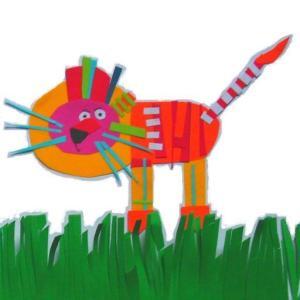Esperimenti scientifici per bambini – Turbina ad acqua: per pressione idrostatica si intende la pressione che un liquido come l’acqua, esercita quando è a riposo. Questa proprietà viene sfruttata da secoli per la costruzione di fontane, orologi ad acqua, e altre macchine.
Esperimenti scientifici per bambini – Turbina ad acqua – Il video mostra un semplicissimo modello di turbina ad acqua.
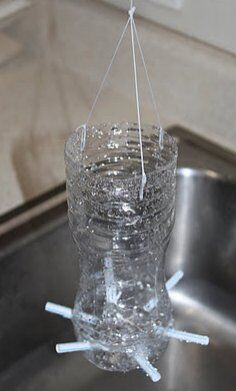
photo credit: http://delightfullearning.blogspot.com/
E’ stato realizzato appendendo al rubinetto una bottiglia tagliata, con dei fori nei quali sono inserite delle cannucce, e mostra come l’acqua generi un movimento di rotazione. Come vedremo meglio poi, la riuscita dell’esperimento dipende dalla precisione con cui si distanziano i fori e la lunghezza e l’inclinazione delle cannucce (se usate) che deve essere il più possibile uniforme. E’ naturalmente importante anche appendere la bottiglia in assetto il più possibile verticale…
Esperimenti scientifici per bambini – Turbina ad acqua – Di seguito altre varianti possibili:
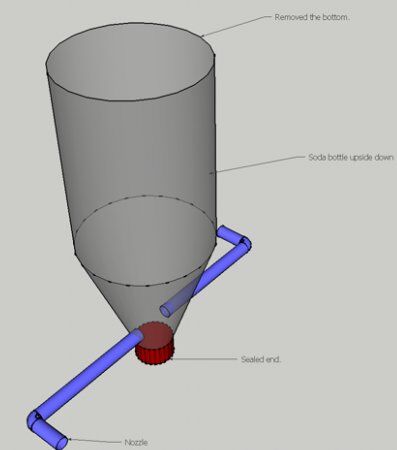
Qui alla bottiglia vengono praticati due soli fori e si usano cannucce snodate, http://www.overunity.com/
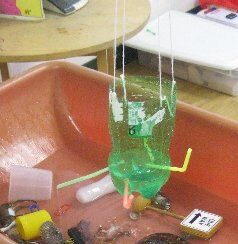
Simile al primo progetto, ma con cannucce snodate, http://www.glendale.edu/
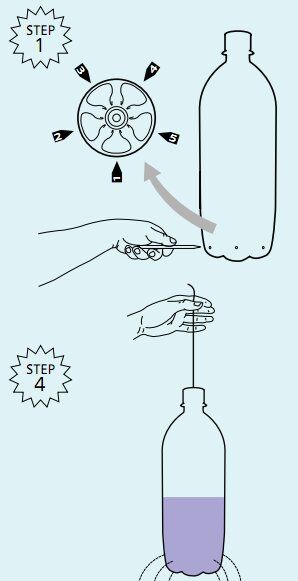
Modello realizzato senza cannucce. (Se si opta per questo progetto è importante forare la bottiglia con un chiodo appuntito e non con cutter o forbici, per ottenere fori precisi), di http://www.thetech.org/islamic_science
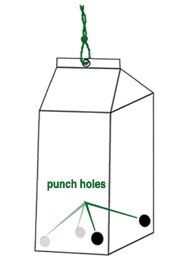
Variante con un cartone del latte (o del succo di frutta). I quattro fori vanno fatti con precisione, e tutti alla stessa altezza e distanza dallo spigolo. http://www.energyquest.ca.gov
Esperimenti scientifici per bambini – Turbina ad acqua – Ma perchè la bottiglia gira su se stessa?
Prima di procedere con l’esperimento vero e proprio, potremmo prendere una prima bottiglia e praticare tre fori, uno sopra l’altro: uno vicino al fondo, uno verso la metà e uno vicino al collo.
Riempendo d’acqua la bottiglia osserveremo che i tre zampilli sono diversi: quello più in basso è più forte e il getto più lungo, gli altri sono progressivamente più deboli.
I bambini così vedranno che l’acqua ha una pressione, e che questa pressione è maggiore sul fondo, cioè la pressione dell’acqua aumenta con la profondità dell’acqua. Come risultato, il getto inferiore, che ha pressione dell’acqua più alta, schizza fuori con maggiore potenza.
Potete anche provare a bloccare uno dei fori con un dito e vedere se ci sono variazioni negli altri getti…
Fatto questo, si può procedere con la costruzione della turbina (seguendo il modello che preferite) e con l’esperimento vero e proprio.
La bottiglia dovrebbe avviare il movimento rotatorio spontaneamente, ma se non succede potete avviarlo con la mano: il bambino non ne sarà deluso e comunque sperimenterà come questo movimento non si interrompe finchè c’è acqua che scorre nella sua turbina. Variando la quantità dell’acqua che esce dal rubinetto, potrà anche vedere come varia la velocità di rotazione.
Se la bottiglia contiene troppa acqua, sarà anche troppo pesante e probabilmente ruoterà più lentamente perchè il suo spostamento richiederà più energia. Se l’acqua è troppo poca, la bottiglia sarà sì più leggera, ma ci sarà anche poca energia (cioè poca pressione idrostatica) per muoverla.
Esperimenti scientifici per bambini – Turbina ad acqua – Ma perchè gira?
L’acqua viene spinta attraverso i fori dalla pressione idrostatica. Siccome tutti i getti fuoriescono nella stessa direzione (cioè dal centro della bottiglia verso l’esterno), questo fa sì che la bottiglia venga spinta verso la direzione opposta e che quindi cominci a ruotare su se stessa.
Si tratta della terza legge del moto di Newton: per ogni azione corrisponde una reazione uguale e contraria.
L’azione dell’acqua di zampillare all’esterno provoca una reazione uguale nella bottiglia: questo esperimento dimostra appunto che le forze agiscono in coppia azione-reazione.
Le turbine delle centrali idroelettriche funzionano proprio così.

Science experiments for kids: water turbin. For “hydrostatic pressure” it is meant the pressure that a liquid such as water, exerts when it is at rest. This property is exploited for centuries for the construction of fountains, water clocks, and other machines.
The video shows a very simple model of water turbine:

photo credit: http://delightfullearning.blogspot.com/
It was done by hanging at the tap a bottle cut in half, with holes in which are inserted the straws, and it shows how the water generate a rotational movement. As we shall see later, the success of the experiment depends on the accuracy with which distance themselves from the holes and the length and inclination of the straws (if used) which must be as uniform as possible.
It is of course also important to hang the bottle as vertical as possible.
Science experiments for kids: water turbine
Other projects:

Here to the bottle only two holes are drilled and are used straws jointed, http://www.overunity.com/


Model made without straws, by http://www.thetech.org/islamic_science

Variant with a milk carton by http://www.energyquest.ca.gov
Science experiments for kids: water turbine
But why the bottle turns on itself?
Before proceeding with the actual experiment, we could take a first bottle and drill three holes, one above the other, one near the bottom, one towards the middle and one near the neck.
Filling water bottle will observe that the three jets are different: the lower one is stronger and the jet longer, others are progressively weaker.
The children so will see that the water has a pressure, and that this pressure is greater on the bottom, that is, the water pressure increases with depth of the water. As a result, the lower jet, which has the highest water pressure, splashes out with greater power.
You can also try to block a hole with your finger and see if there are changes in other jets …
That done, you can proceed with the construction of the turbine (following the model of your choice) and with the actual experiment.
The bottle should start the rotational movement spontaneously, but if not happens you can start it with your hand: the child will not be disappointed and still experience how this movement will not stop until there is flowing water in its turbine. By varying the amount of water coming out of the tap, you will also see how varied the speed of rotation.
If the bottle contains too much water, it will be too heavy and probably will rotate more slowly because its shift will require more energy. If the water is too low, the bottle will ensure lighter, but there will be little energy (ie low hydrostatic pressure) to move it.
Science experiments for kids: water turbine
Why?
The water is pushed through the holes by the hydrostatic pressure. Since all the jets protrude in the same direction (that is, from the center towards the outside of the bottle), this means that the bottle is pushed towards the opposite direction and then begins to rotate on itself.
This is the third law of motion by Newton: for every action there is an equal and opposite reaction.
The action of water to gush outside causes an equal reaction in bottle: This experiment demonstrates precisely that the forces act in pairs action-reaction.
The turbines of the hydroelectric power plants work just as well.

